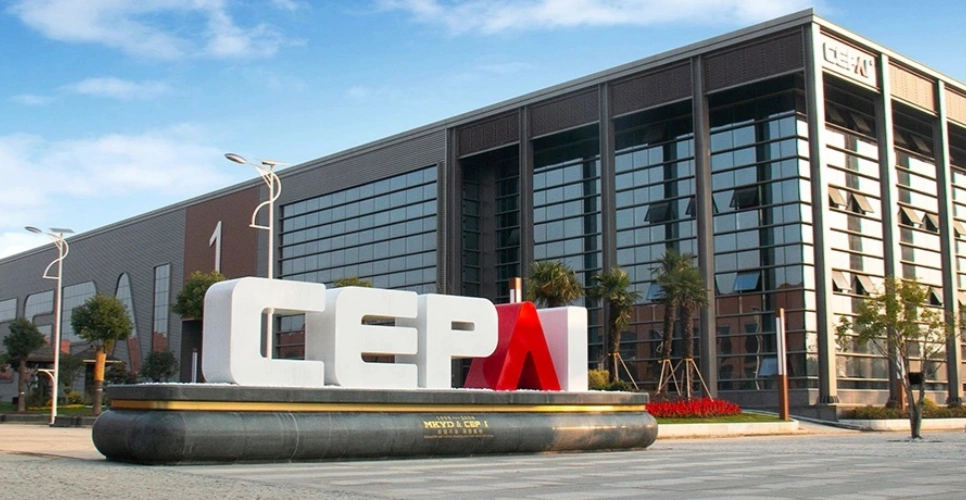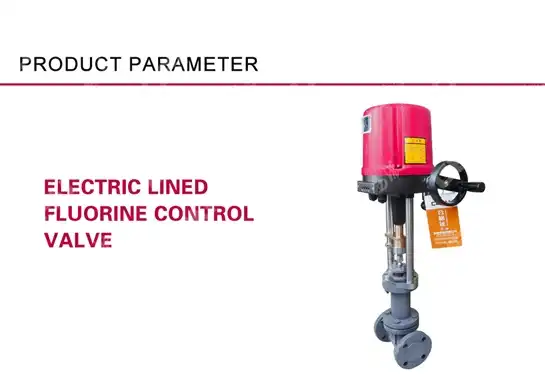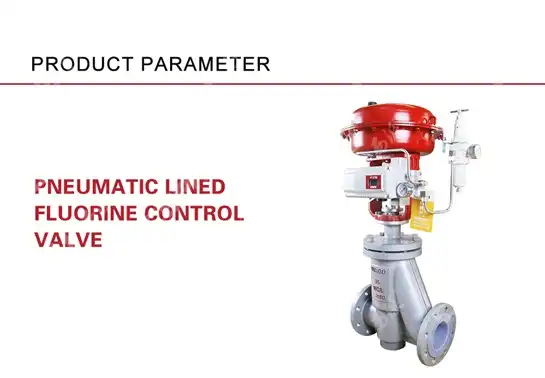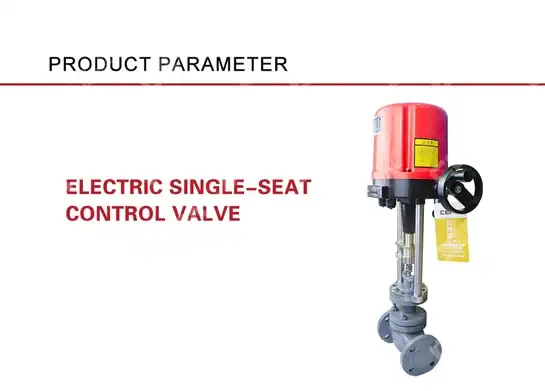Key Differences Between Pneumatic and Electric Control Valves
In modern industrial automation systems, control valves serve as critical components that regulate fluid flow, pressure, and temperature across various applications. Understanding the fundamental differences between pneumatic and electric control valves is essential for engineers and procurement specialists who need to select the most appropriate valve technology for their specific operational requirements. Pneumatic control valves operate using compressed air as the power source, while electric control valves use an electric motor to generate linear or rotary motion. The choice between these two technologies significantly impacts system performance, maintenance requirements, installation costs, and operational efficiency. A Pneumatic Control Valve offers distinct advantages in terms of speed and safety, particularly in hazardous environments where electrical components might pose risks. This comprehensive analysis explores the key technical differences, application considerations, and selection criteria to help industrial professionals make informed decisions when specifying control valve systems for their facilities.

Operational Mechanisms and Power Sources
Understanding the fundamental operating principles of pneumatic and electric control valves provides insight into their respective strengths and limitations across different industrial applications.
Pneumatic Control Valve Operating Principles
Pneumatic control valves operate using compressed air as the power source, with a cylinder as the actuator driven by electrical valve positioners. The compressed air system creates mechanical force through pressure differential across a diaphragm or piston assembly, translating pneumatic pressure into linear motion that positions the valve stem and controls flow characteristics. This technology relies on a continuous supply of clean, dry compressed air typically maintained at pressures ranging from 15 to 100 PSI depending on the application requirements. The pneumatic actuator's response time is exceptionally fast due to the compressible nature of air, making these systems ideal for applications requiring rapid valve positioning changes. Additionally, the inherent fail-safe capabilities of pneumatic systems allow valves to automatically move to predetermined positions during air supply failures, providing crucial safety features in critical process applications. The simplicity of pneumatic operation also contributes to reduced maintenance complexity, as the mechanical components are generally more robust and less susceptible to electronic failures compared to their electric counterparts.
Electric Control Valve Operating Principles
Electric control valves utilize electric motors, typically stepper motors or servo motors, to generate precise rotary or linear motion for valve positioning. These systems convert electrical energy into mechanical force through electromagnetic principles, offering exceptional positioning accuracy and repeatability. Modern electric actuators often incorporate sophisticated control algorithms that enable precise valve positioning with feedback loops ensuring accurate flow control across varying process conditions. Electric valves offer more precise and accurate control and work well for variable control applications, with longer service life and lower maintenance requirements compared to pneumatic valves. The electric control system can integrate seamlessly with digital control systems, enabling advanced features such as remote monitoring, diagnostic capabilities, and predictive maintenance scheduling. Electric actuators also provide consistent torque output regardless of environmental conditions, making them suitable for applications where precise control is paramount. The elimination of compressed air requirements reduces overall system complexity and eliminates potential air quality issues that could affect valve performance. Pneumatic Control Valve systems, by contrast, rely on compressed air for actuation and have different maintenance and operational characteristics.
Power Supply Infrastructure Requirements
The infrastructure requirements for pneumatic and electric control valves differ significantly in terms of installation complexity and ongoing operational considerations. Pneumatic systems require comprehensive compressed air networks including compressors, air dryers, filtration systems, and distribution piping throughout the facility. This infrastructure represents substantial capital investment and ongoing energy consumption for air compression and treatment. Conversely, electric control valves require electrical power distribution systems that are typically already available in most industrial facilities. The electrical infrastructure generally involves lower installation costs and reduced space requirements compared to pneumatic air supply systems. However, electric systems may require uninterruptible power supply (UPS) systems for critical applications to ensure continuous operation during power outages. The choice between these power sources often depends on existing facility infrastructure and the specific reliability requirements of the process application.
Performance Characteristics and Technical Specifications
The performance differences between pneumatic and electric control valves encompass various technical parameters that directly impact system efficiency and operational effectiveness.
Speed and Response Time Comparison
Pneumatic Control Valves feature fast actuation speeds due to the quick expansion and contraction of air, making them particularly suitable for applications requiring rapid response to process changes. The compressed air system enables stroke times typically ranging from 1 to 10 seconds for full valve travel, depending on actuator size and air pressure availability. This rapid response capability makes pneumatic valves ideal for emergency shutdown systems and applications where quick flow interruption is critical for safety or process control. Electric control valves generally exhibit slower response times due to the mechanical nature of motor-driven systems, with typical stroke times ranging from 15 seconds to several minutes depending on motor characteristics and valve size. However, electric actuators compensate for slower speed with superior positioning accuracy and the ability to maintain precise intermediate positions throughout their stroke range. The speed advantage of pneumatic systems becomes particularly pronounced in large valve applications where electric motors would require significant gear reduction to generate adequate torque.
Torque and Force Generation Capabilities
Pneumatic actuators typically provide high force and speed in a smaller footprint depending on available air pressure supply than electric actuators. The force generation capability of pneumatic actuators is directly proportional to air pressure and actuator effective area, allowing for substantial torque output even in compact designs. Electric Control Valves generally provide lower torque compared to pneumatic valves, though modern designs can offer enhanced performance with appropriate gear systems. However, electric actuators offer consistent torque characteristics throughout their operating range, while pneumatic actuator force varies with air pressure fluctuations. The torque consistency of electric systems provides more predictable valve performance across varying process conditions. For applications requiring extremely high torque output, pneumatic systems often prove more cost-effective than electric alternatives, particularly when considering the size and complexity of electric motor and gear systems required to achieve equivalent force levels. Pneumatic Control Valve systems remain a preferred choice in such scenarios.
Precision and Control Accuracy
Electric control valves excel in applications demanding high precision and repeatability, offering positioning accuracy typically within ±0.1% of full scale with advanced feedback systems. The digital control capabilities of electric actuators enable sophisticated control algorithms including PID control, anti-windup features, and adaptive tuning parameters that optimize valve performance for specific process characteristics. Modern electric valve systems incorporate position feedback devices such as potentiometers, resolvers, or encoders that provide real-time position information for closed-loop control systems. Pneumatic control valves, while generally less precise in absolute positioning, offer excellent proportional control capabilities suitable for most industrial applications. The positioning accuracy of pneumatic systems typically ranges from ±1% to ±3% of full scale, which proves adequate for many process control requirements. However, pneumatic systems may experience position drift due to air leakage or pressure variations, requiring periodic calibration to maintain optimal performance standards.
Application Domains and Industry Implementation
The selection between pneumatic and electric control valves often depends on specific industry requirements, environmental conditions, and operational priorities.

Hazardous Environment Applications
Pneumatic control valves demonstrate significant advantages in hazardous environments where explosive atmospheres or flammable materials are present. The absence of electrical components in the actuator mechanism eliminates potential ignition sources, making pneumatic systems inherently safer for applications in chemical processing plants, refineries, and offshore drilling platforms. The compressed air power source cannot create sparks or generate heat that could trigger explosions in volatile environments. Additionally, pneumatic systems maintain their fail-safe characteristics even during electrical power failures, automatically positioning valves to predetermined safe positions based on spring return mechanisms. Electric control valves require specialized explosion-proof enclosures and intrinsically safe electrical circuits when used in hazardous locations, significantly increasing system complexity and installation costs. The certification requirements for electric systems in explosive atmospheres involve rigorous testing and documentation procedures that extend project timelines and increase overall system costs.
Process Industry Applications
The petrochemical and oil & gas industries extensively utilize both pneumatic and electric control valve technologies depending on specific application requirements. Pneumatic Control Valve systems excel in upstream oil and gas applications where rapid response times are crucial for well control and safety systems. The robust nature of pneumatic actuators withstands harsh environmental conditions including extreme temperatures, corrosive atmospheres, and mechanical vibrations commonly encountered in drilling and production operations. Electric control valves find widespread application in downstream refining processes where precise flow control and advanced automation capabilities enhance product quality and operational efficiency. The integration capabilities of electric systems with distributed control systems (DCS) and supervisory control and data acquisition (SCADA) systems enable sophisticated process optimization strategies. Power generation facilities increasingly adopt electric control valves for their precise control capabilities and reduced maintenance requirements, particularly in applications where compressed air systems are not readily available.
Water Treatment and Municipal Applications
Municipal water treatment facilities and industrial water processing systems present unique requirements that influence valve technology selection. Electric control valves offer advantages in water treatment applications due to their precise positioning capabilities and integration with automated treatment processes. The elimination of compressed air requirements reduces system complexity and potential contamination sources in potable water systems. Pneumatic control valves remain popular in applications requiring fail-safe operation during power outages, ensuring continued water supply and treatment capabilities during emergency conditions. The energy efficiency considerations become particularly important in municipal applications where operational costs directly impact utility rates and environmental sustainability goals. Electric valve systems typically demonstrate lower long-term energy consumption compared to pneumatic systems that require continuous air compression and treatment.
Conclusion
The selection between pneumatic and electric control valves requires careful consideration of multiple factors including response time requirements, precision needs, environmental conditions, and long-term operational costs. Pneumatic valves excel in speed and safety, while electric valves offer precision and energy efficiency. Each technology offers distinct advantages that make them suitable for specific applications within modern industrial automation systems.
As a leading China Pneumatic Control Valve manufacturer, CEPAI Group Co., Ltd. leverages advanced intelligent manufacturing capabilities to deliver superior valve solutions for global markets. Our state-of-the-art facility combines precision engineering with innovative automation technologies, ensuring optimal performance across diverse industrial applications. Whether you require high-speed pneumatic systems for safety-critical applications or precision electric control valves for advanced process automation, CEPAI's comprehensive product portfolio addresses the most demanding operational requirements.
With over 15 years of specialized experience as a trusted China Pneumatic Control Valve supplier, CEPAI maintains rigorous quality standards through ISO certification systems and comprehensive testing protocols. Our engineering team provides expert technical consultation to help you select the optimal valve technology for your specific application requirements. From concept through installation and ongoing support, CEPAI delivers complete valve solutions that maximize system performance and operational reliability.
Discover competitive Pneumatic Control Valve price options and explore our extensive catalog of high-performance valve solutions. As a premier China Pneumatic Control Valve wholesale provider, we offer customized solutions tailored to your specific industry requirements. Our global service network ensures responsive technical support and maintenance services wherever your operations are located.
Contact CEPAI today to discuss your control valve requirements and experience the difference that advanced engineering and manufacturing excellence can make for your industrial automation systems. For technical specifications, quotations, or application consultations, reach out to our expert team at cepai@cepai.com. Partner with CEPAI Group Co., Ltd., your trusted China Pneumatic Control Valve factory, and elevate your industrial process control to new levels of performance and reliability.
References
1. Smith, J.A., and Martinez, R.K. "Comparative Analysis of Pneumatic and Electric Actuator Technologies in Industrial Control Systems." Journal of Process Control Engineering, Vol. 45, No. 3, 2023, pp. 112-128.
2. Thompson, M.L., Chen, W.H., and Roberts, D.J. "Performance Evaluation of Control Valve Technologies in Harsh Industrial Environments." International Review of Automation Technology, Vol. 38, No. 7, 2024, pp. 89-105.
3. Anderson, P.B., and Kumar, S.N. "Energy Efficiency Comparison of Pneumatic versus Electric Valve Actuation Systems." Industrial Energy Management Quarterly, Vol. 29, No. 2, 2024, pp. 67-82.
4. Williams, K.R., Garcia, A.M., and Zhang, L.F. "Safety and Reliability Assessment of Control Valve Technologies in Hazardous Process Applications." Process Safety and Environmental Protection Journal, Vol. 156, 2023, pp. 203-219.
_1745994738000.webp)
Get professional pre-sales technical consultation and valve selection services, customized solution services.

About CEPAI


